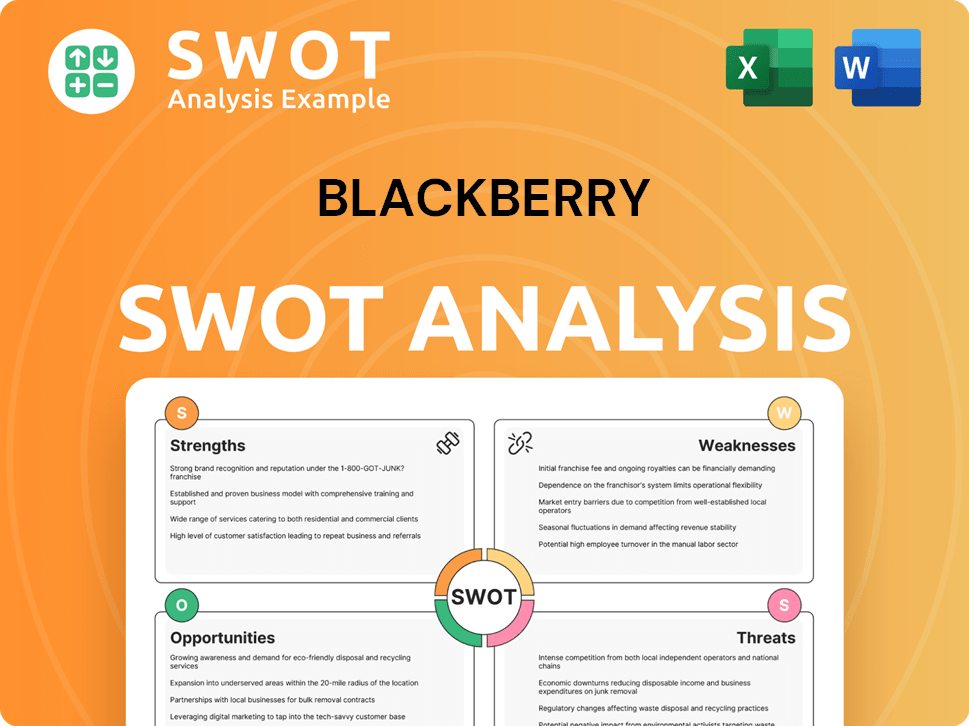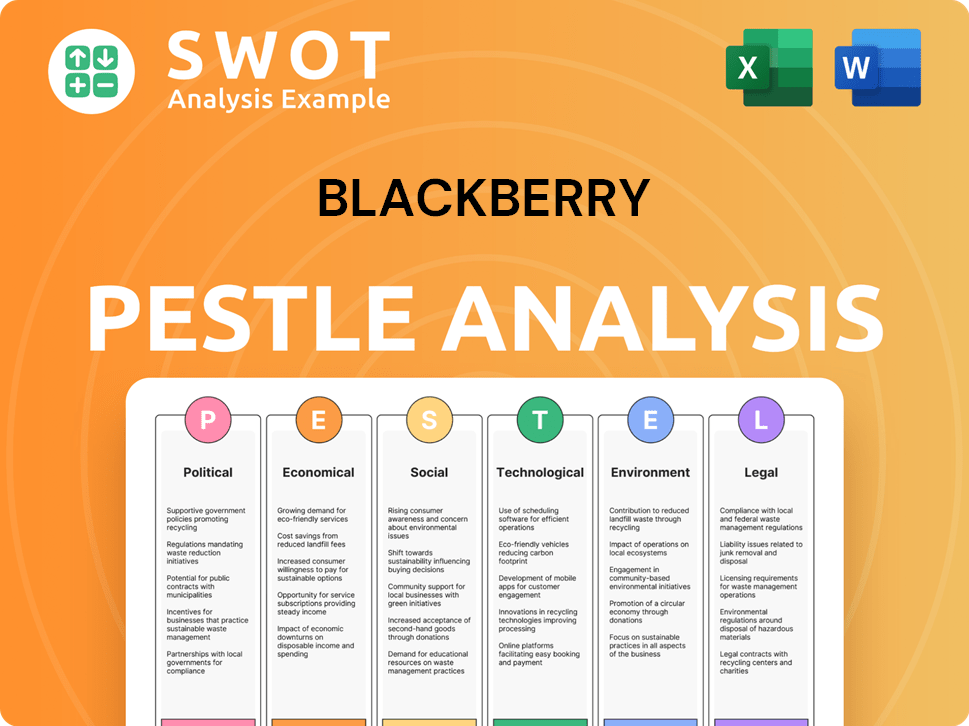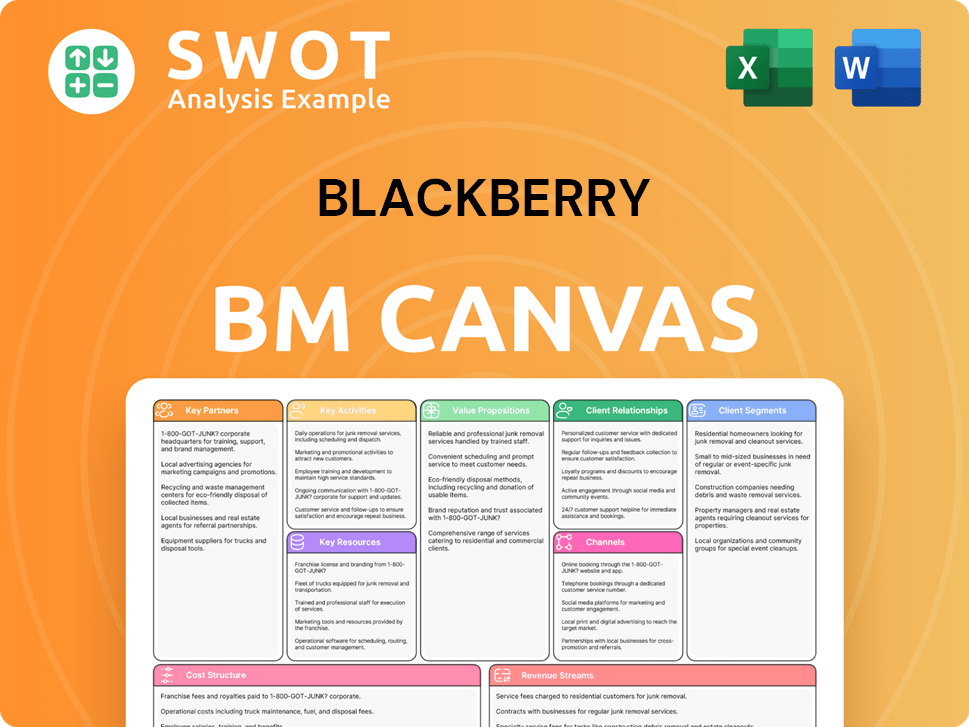BlackBerry Bundle
Can BlackBerry Reclaim Its Technological Throne?
BlackBerry's journey from mobile titan to cybersecurity innovator is a fascinating study in strategic adaptation. This transformation, born from the ashes of the BlackBerry SWOT Analysis, now positions the company at the forefront of enterprise security and the Internet of Things (IoT). But what does the future hold for this iconic brand, and how is it navigating the complex currents of the tech industry?

This deep dive into BlackBerry's growth strategy will explore its shift from the mobile industry to software and services, examining its current market position and business strategy. We'll analyze BlackBerry's future prospects, including its strategic initiatives for growth, its financial performance and outlook, and the impact of 5G on its trajectory. Understanding BlackBerry's competitive advantages and disadvantages is crucial to assessing its potential for innovation and disruption in this dynamic landscape.
How Is BlackBerry Expanding Its Reach?
The expansion initiatives of the company are primarily focused on strengthening its presence in the enterprise and government security software markets. This is coupled with a strategic push into the automotive and general embedded IoT sectors. The company is leveraging its existing strengths and exploring new opportunities to drive growth.
A key aspect of their strategy involves expanding the reach of the QNX operating system within the automotive industry. They are aiming to capitalize on the growing trend of software-defined vehicles. In cybersecurity, the company is focused on expanding its unified endpoint security (UES) and unified endpoint management (UEM) offerings to a broader customer base.
The company's approach includes organic growth through product enhancements and strategic customer acquisitions. This is complemented by exploring international expansion opportunities for its core software and services. The company's strategic focus is on enhancing existing product capabilities and potentially exploring strategic partnerships or acquisitions to expand its solution portfolio and market access.
The company is actively pursuing new design wins with major automotive OEMs. The QNX operating system is a dominant player in car infotainment and advanced driver-assistance systems (ADAS). This expansion is crucial as the automotive industry increasingly relies on software.
The company is targeting a broader range of enterprise customers across various industries, including financial services and government. The focus is on expanding its unified endpoint security (UES) and unified endpoint management (UEM) offerings. This involves enhancing existing product capabilities.
The company may explore strategic partnerships or bolt-on acquisitions to expand its solution portfolio and market access. This approach supports the company's growth strategy by providing access to new technologies and markets. The company's focus remains on organic growth through product enhancements.
The company is exploring opportunities for international expansion of its core software and services. This includes identifying new markets and adapting its offerings to meet local needs. This strategy aims to increase revenue and market share globally.
The company's expansion strategy is multi-faceted, involving organic growth, strategic partnerships, and potential acquisitions. The company is also investing in cybersecurity solutions, particularly its Cylance AI-driven platform, to provide predictive threat prevention. The company's focus on the automotive industry, especially with its QNX operating system, and its expansion into cybersecurity solutions are key components of its long-term business plan. For more details on the company's business model, consider reading the article on Revenue Streams & Business Model of BlackBerry.
The company's strategic initiatives for growth include expanding in the automotive sector and bolstering its cybersecurity offerings. These moves are designed to leverage existing strengths and capitalize on market trends. The company is also focused on organic growth and strategic partnerships.
- Focus on QNX for automotive.
- Expansion of UES and UEM in cybersecurity.
- Potential strategic partnerships and acquisitions.
- International expansion of core software and services.
BlackBerry SWOT Analysis
- Complete SWOT Breakdown
- Fully Customizable
- Editable in Excel & Word
- Professional Formatting
- Investor-Ready Format

How Does BlackBerry Invest in Innovation?
The core of the company's innovation and technology strategy centers on artificial intelligence (AI), machine learning (ML), and its proprietary QNX operating system. This approach is designed to fuel growth in cybersecurity and the Internet of Things (IoT). The company consistently invests in research and development (R&D), allocating a significant portion to enhance its AI-driven cybersecurity platform and expand the capabilities of its QNX real-time operating system for embedded systems. This focus reflects a broader digital transformation strategy aimed at providing secure, intelligent software solutions.
BlackBerry's strategic initiatives for growth are deeply intertwined with its technological advancements. The company leverages its expertise in cybersecurity, embedded systems, and wireless communications to offer differentiated and highly secure solutions. This approach is crucial for maintaining a strong BlackBerry market position and capitalizing on emerging opportunities in the evolving tech landscape. The company's focus on innovation is a key element in its long-term business plan.
The company's commitment to innovation is evident in its extensive patent portfolio, which includes numerous patents in cybersecurity, embedded systems, and wireless communications. This commitment to technological leadership is a cornerstone of its growth objectives. By consistently innovating in these areas, the company aims to provide unique and highly secure solutions to its target markets, thereby driving sustainable growth and enhancing its competitive advantages.
The company emphasizes predictive threat prevention using AI within its Cylance cybersecurity platform. This proactive approach aims to stay ahead of evolving cyber threats. This strategy is crucial for maintaining a strong position in the cybersecurity market.
QNX is a foundational technology for advanced automotive systems, powering over 235 million vehicles worldwide as of early 2024. The QNX platform's expansion and enhancement remain a key focus. This technology is a vital part of the company's strategy in the automotive industry.
The company consistently invests in research and development (R&D) to drive innovation. A significant portion of this investment is allocated to enhancing its AI-driven Cylance cybersecurity platform and expanding the capabilities of its QNX real-time operating system. This investment is crucial for the company's long-term growth.
The company holds numerous patents in areas such as cybersecurity, embedded systems, and wireless communications. This extensive patent portfolio demonstrates a strong commitment to technological leadership. This commitment is a key factor in its competitive advantages.
The company focuses on providing secure, intelligent software solutions that enable automation and connectivity across various industries. This expansion into software and services is a key element of its business strategy. This approach allows the company to serve a broader market.
The impact of 5G on the company's future is significant, particularly in the automotive and IoT sectors. The company's technology is well-positioned to benefit from the increased connectivity and data processing capabilities of 5G. This positions the company for future growth.
The company's approach to digital transformation is evident in its focus on providing secure, intelligent software solutions. The company is enhancing its AI-driven Cylance cybersecurity platform and expanding the capabilities of its QNX real-time operating system for embedded systems. The company's strategic initiatives for growth are deeply intertwined with its technological advancements.
- Leveraging AI and ML for predictive cybersecurity.
- Expanding the QNX platform for automotive and IoT applications.
- Investing in R&D to maintain technological leadership.
- Focusing on secure, intelligent software solutions.
To understand the competitive landscape, it's important to consider the company's position relative to its Competitors Landscape of BlackBerry. The company's focus on innovation and technology is critical for navigating the challenges and opportunities in the current market and for achieving its long-term business plan. The company's investment in cybersecurity solutions and its role in the automotive industry are key factors in its future prospects.
BlackBerry PESTLE Analysis
- Covers All 6 PESTLE Categories
- No Research Needed – Save Hours of Work
- Built by Experts, Trusted by Consultants
- Instant Download, Ready to Use
- 100% Editable, Fully Customizable

What Is BlackBerry’s Growth Forecast?
The financial outlook for the company is shaped by its strategic pivot towards software and services. The company's financial health is closely watched by investors and analysts, as it reflects the success of its transformation. The company is focused on leveraging its core strengths in cybersecurity and the Internet of Things (IoT) to drive sustainable growth.
For the fiscal year ending February 29, 2024, the company reported a total revenue of $665 million. The IoT segment contributed $206 million to this revenue, while the Cybersecurity segment generated $392 million. This demonstrates the company's diversification and its focus on high-growth areas.
The company anticipates positive free cash flow in fiscal year 2025. This is a key indicator of financial stability and the ability to invest in future growth. Analysts' forecasts for the company's revenue in fiscal year 2025 range from approximately $679 million to $710 million, indicating expectations of continued, albeit moderate, growth.
The company's revenue is primarily generated from its IoT and Cybersecurity segments. In fiscal year 2024, the IoT segment contributed $206 million, and the Cybersecurity segment contributed $392 million. This shows the company's strategic focus on these key areas.
The company's financial strategy emphasizes sustainable profitability and cash flow generation. This is achieved through operational efficiencies and scaling its software businesses. The goal is to ensure long-term financial stability and support future growth initiatives. The company's Mission, Vision & Core Values of BlackBerry provide a framework for its strategic direction.
Analysts predict revenue in fiscal year 2025 to be between $679 million and $710 million. The company's focus on improving profit margins through operational efficiencies is a key part of its financial strategy. This outlook suggests continued, albeit modest, growth.
While specific long-term revenue targets aren't always publicly stated, the company's financial strategy supports its growth ambitions. The focus is on sustainable profitability and cash flow, which will allow the company to invest in its core software and services offerings. The company is working on strategies for regaining market share.
BlackBerry Business Model Canvas
- Complete 9-Block Business Model Canvas
- Effortlessly Communicate Your Business Strategy
- Investor-Ready BMC Format
- 100% Editable and Customizable
- Clear and Structured Layout

What Risks Could Slow BlackBerry’s Growth?
The growth strategy of the company faces several potential risks and obstacles. These challenges primarily stem from intense market competition, the dynamic nature of cybersecurity threats, and economic uncertainties. Successfully navigating these areas is crucial for the company's future prospects.
In the competitive cybersecurity market, the company must continuously innovate to stay ahead. Regulatory changes and supply chain issues could also impact operations. Furthermore, technological disruptions, such as advancements in AI and quantum computing, pose both opportunities and threats, requiring significant R&D investment.
Internally, resource constraints, including attracting and retaining top talent, could impede growth. The company has demonstrated its ability to overcome challenges, as seen in its transition from hardware to software. Management addresses these risks through market analysis and strategic planning.
The cybersecurity market is highly competitive, with numerous established players and agile startups. This necessitates continuous innovation and adaptation. The company must differentiate itself to maintain its market position and achieve its BlackBerry growth strategy.
The evolving nature of cybersecurity threats presents a constant challenge. The increasing sophistication of attacks, including state-sponsored cyberattacks, requires robust and proactive security measures. Staying ahead of these threats is critical for the company's future prospects.
Economic uncertainties, such as inflation and potential recessions, can impact the company's financial performance and investment decisions. These factors influence market demand and the ability to secure funding for strategic initiatives. The company's business strategy must be flexible to address these challenges.
Changes in global regulations, particularly concerning data privacy and security standards, can affect the company's operations. Compliance with these regulations requires ongoing adjustments to products and services. Understanding and adapting to these changes is essential for the company's long-term business plan.
Supply chain vulnerabilities, while less impactful than in the hardware era, can still affect the delivery of components and services. Disruptions can lead to delays and increased costs. The company must maintain a resilient supply chain to support its expansion into software and services.
Rapid advancements in AI and quantum computing present both opportunities and threats. Significant R&D investment is required to stay relevant and capitalize on these technological shifts. The company's potential for innovation and disruption depends on its ability to adapt.
Attracting and retaining top talent in specialized fields like AI and cybersecurity is crucial but challenging. Competition for skilled professionals is intense. The company must offer competitive compensation and a compelling work environment to maintain its competitive advantages and ensure its long-term business plan.
Securing interconnected IoT ecosystems is complex and presents emerging risks. The increasing number of connected devices creates more potential entry points for cyberattacks. The company's strategies for regaining market share must include robust IoT security solutions. To gain more insights, you can learn more about the Target Market of BlackBerry.
BlackBerry Porter's Five Forces Analysis
- Covers All 5 Competitive Forces in Detail
- Structured for Consultants, Students, and Founders
- 100% Editable in Microsoft Word & Excel
- Instant Digital Download – Use Immediately
- Compatible with Mac & PC – Fully Unlocked

Related Blogs
- What are Mission Vision & Core Values of BlackBerry Company?
- What is Competitive Landscape of BlackBerry Company?
- How Does BlackBerry Company Work?
- What is Sales and Marketing Strategy of BlackBerry Company?
- What is Brief History of BlackBerry Company?
- Who Owns BlackBerry Company?
- What is Customer Demographics and Target Market of BlackBerry Company?
Disclaimer
All information, articles, and product details provided on this website are for general informational and educational purposes only. We do not claim any ownership over, nor do we intend to infringe upon, any trademarks, copyrights, logos, brand names, or other intellectual property mentioned or depicted on this site. Such intellectual property remains the property of its respective owners, and any references here are made solely for identification or informational purposes, without implying any affiliation, endorsement, or partnership.
We make no representations or warranties, express or implied, regarding the accuracy, completeness, or suitability of any content or products presented. Nothing on this website should be construed as legal, tax, investment, financial, medical, or other professional advice. In addition, no part of this site—including articles or product references—constitutes a solicitation, recommendation, endorsement, advertisement, or offer to buy or sell any securities, franchises, or other financial instruments, particularly in jurisdictions where such activity would be unlawful.
All content is of a general nature and may not address the specific circumstances of any individual or entity. It is not a substitute for professional advice or services. Any actions you take based on the information provided here are strictly at your own risk. You accept full responsibility for any decisions or outcomes arising from your use of this website and agree to release us from any liability in connection with your use of, or reliance upon, the content or products found herein.